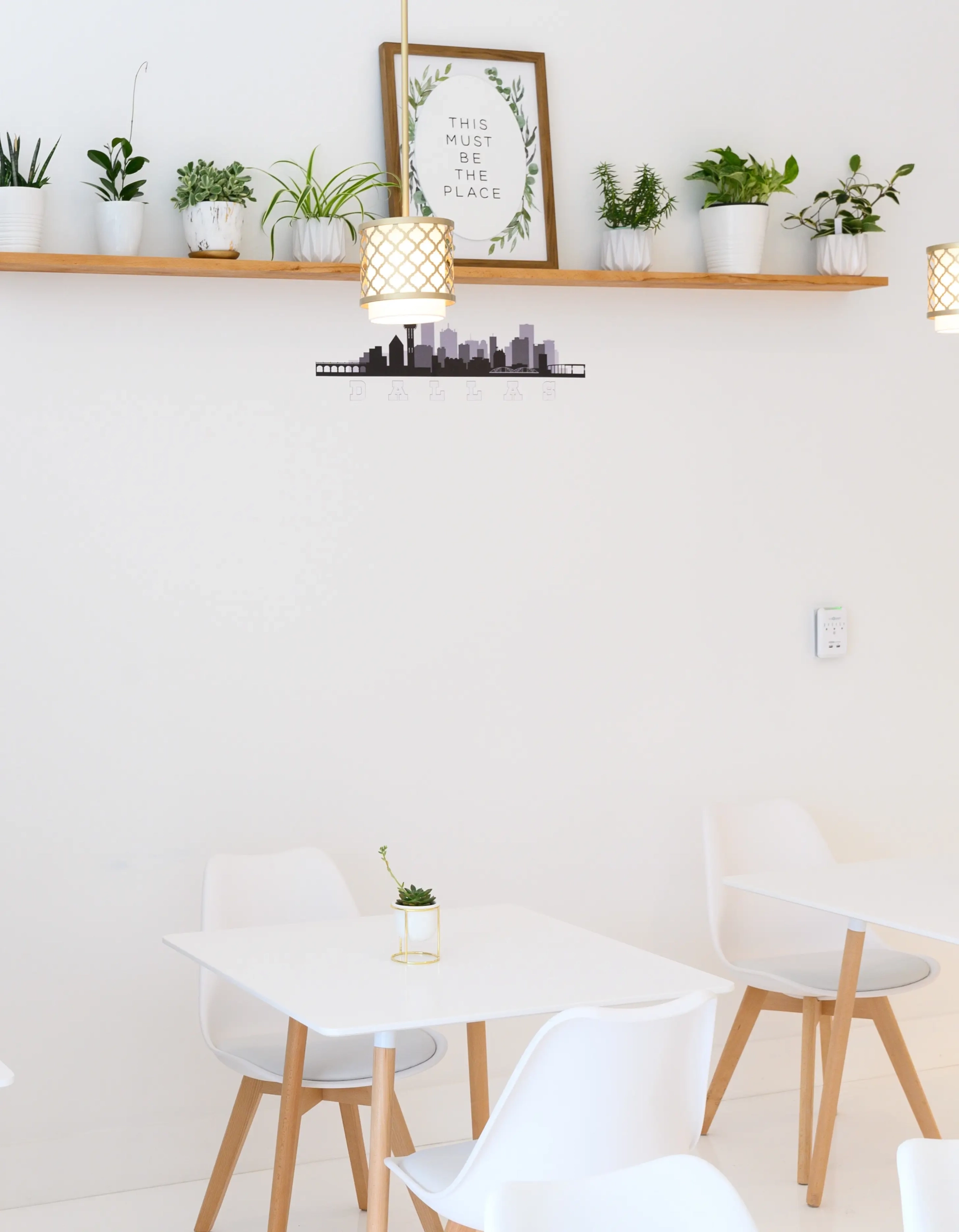explore a modern two-column layout
Imagine a sleek and modern two-column design that effortlessly showcases your content! On the left, there’s a captivating image of a workspace complete with a motivational poster, desk essentials, and lush plants. This vibrant touch draws viewers in, making your audience feel right at home. On the right, a well-organised vertical list highlights your offerings, like a café menu, with easy-to-read text entries and their corresponding prices.
key features
- Overall structure: The two-column layout adeptly separates visual content and text, creating a harmonious user experience.
- Asymmetry: With visually balanced asymmetry, the large image on the left captures attention while the text-rich right column effectively conveys information.
elements that stand out
- Left column: A stunning landscape-oriented image portraying a productive workspace, complete with a motivational poster that matches your theme.
- Right column: An eye-catching header, “Our Full Menu,” followed by a neatly organised list of offerings, making information easily accessible.
design details
- Typography: Use bold, prominent headers paired with legible content text for clarity and impact.
- White space: Generous white space surrounds your elements, creating a clean and welcoming look while enhancing readability.
- Responsive design: This layout seamlessly adapts to different screen sizes, ensuring content remains engaging across devices.
accessibility and style
The modern and minimalist style emphasises simplicity and legibility, making your content approachable for all users. The contrast between text and background enhances readability and ensures your message is effectively communicated.
why choose this layout?
This innovative design not only captivates viewers but also optimises their experience through efficient content delivery. Whether you’re showcasing a menu, services, or workspace inspiration, this clean and stylish layout is perfect for your WordPress website. Embrace the modern aesthetic and elevate your content today!
ways to organise content in WordPress
using categories
Categories help you group your posts in a logical structure. By organising content into categories, you make it easier for readers to find related posts. For example, if you have a blog about cooking, categories could include “Main Dishes,” “Desserts,” and “Appetisers.” Using categories also helps search engines understand your content. To make the most of categories, ensure they’re distinct and encompass all the topics you cover. You can easily manage categories in WordPress’s admin panel and assign them when creating posts.
tags
Tags are like categories’ smaller siblings. They allow you to add more specific descriptors to your posts, helping users discover related content. For instance, within a “Main Dishes” category, you could use tags like “vegetarian,” “quick meals,” or “pasta.” While categories provide a broad taxonomy, tags offer more nuanced organisation. Balancing the use of categories and tags creates a comprehensive navigation system for both users and search engines, enhancing your WordPress navigation menus.
pages
Pages are perfect for timeless content like your “About Us,” “Contact,” or “Services” sections. Unlike posts, which are displayed in chronological order, pages remain static, making them ideal for information that doesn’t change often. They help create a foundational structure for your WordPress website. Use pages to introduce yourself or your business to your audience, and ensure they contain all the essential information visitors might need at their fingertips.
custom post types
Beyond posts and pages, WordPress allows you to create custom post types for more flexible content management. Whether you run a real estate site with property listings or a movie review blog, custom post types help tailor your site’s structure. They provide separate organisational areas, making it easy to manage diverse content on a single site. With plugins or a little coding know-how, adding custom post types enables tailored features that suit specific content needs.
menus
Menus offer clear paths for navigation, leading your audience through your website. A well-structured menu guides visitors to important areas of your site, improving user experience. Organise your menu based on user priorities, ensuring it’s both logical and intuitive. Use dropdowns for nested menu items, but don’t overcomplicate things. Simplicity is key. For the latest options in menu design, you may explore the benefits of WordPress block themes, which offer enhanced customisation.
sidebars
Sidebars can enhance your site by displaying widgets and secondary content like recent posts, social media links, or promotional material. They allow you to disseminate information without overwhelming your main content. Consider the Gutenberg blocks that let you place dynamic widgets in your sidebar. A well-utilised sidebar keeps your audience engaged while offering them further avenues to discover more about your site or products.
footers
Footers provide a consistent way to present important information at the bottom of every page. They typically include contact information, social media links, or subscription call-to-actions. You can also incorporate navigation links for seamless browsing. Enhance the footer’s usability by making it clean and straightforward, aligning with the overall theme of your website. When tailored thoughtfully, footers can significantly contribute to the user experience and website engagement.
widgets
Widgets are small content blocks that can be added to your site’s sidebars, footer, and other widget-ready areas. They’re an efficient way to display dynamic content, like calendars, search forms, or recent comments. By leveraging responsive WordPress design, widgets can enhance the functionality and customisation of your website. Arrange and edit them directly through the WordPress admin panel to suit your layout and design preferences.
archives
Archives offer a systematic way to display past content sorted by month, category, or author. They provide an easy path for visitors interested in your back catalogue. Archive pages enhance site navigation, benefiting both users and search indexing. Effective use of archives fosters continuous discovery, keeping your content evergreen. These are usually generated automatically and can be conveniently managed within WordPress settings.
bread crumbs
Bread crumbs provide a secondary navigation aid, showing users the path taken to arrive at a page. This improves the user experience, offering them straightforward navigation assistance and context. Bread crumbs are particularly useful for sites with extensive multi-layered navigation. Displaying them near the top of a page allows users to trace back their steps easily, ensuring they can navigate your content effectively.
different types of content in WordPress
blog posts
Blog posts are dynamic, regularly updated pieces that keep your site fresh and engaging. They’re perfect for sharing insights, news, tutorials, or personal stories. Posts show up in chronological order and can be organised with categories and tags to help readers find related content easily. By maintaining a consistent blogging schedule, you can improve SEO and build reader loyalty, helping your WordPress website expand its reach effectively over time.
pages
Pages are static pieces of content ideal for perpetually relevant information like “About Us” sections, mission statements, or terms and conditions. They are timeless, seeing little change once published. Unlike posts, pages don’t show up in the blog feed and are generally linked directly from your website’s menu. Their static nature and hierarchal structure provide a reliable template for essential user information and help to organise your site’s fundamental offerings.
portfolios
Portfolios showcase your work or projects, and are particularly useful for creatives, freelancers, and service providers. In WordPress, portfolios can be created using specific templates or plugins, offering a visually appealing way to organise and present your work. You’ll be able to display images, project descriptions, and even client testimonials in a structured format, enabling visitors to explore your capabilities and style seamlessly.
galleries
Galleries allow you to display images in an organised manner, optimal for photographers, artists, or any content creator focusing on visuals. A variety of gallery plugins are available that offer opportunities to create slideshows, tiled image layouts, or even lightbox effects. Galleries enhance your website’s aesthetic by providing an engaging, interactive experience, making them an excellent choice for visually-driven content.
events
For those running events or workshops, maintaining an events calendar on your WordPress site is essential. With the help of plugins, you can present upcoming events in calendar view, with details, RSVP options, and maps. Event content supports interactive engagement, enabling users to plan attendance and increase participation effectively. Whether for a one-time event or recurring meetups, an events page can simplify management and communicate your schedule effectively.
testimonials
Testimonials offer credibility, showcasing honest feedback from satisfied clients or customers. Adding testimonials to your WordPress templates can enhance trustworthiness and business appeal. Display them prominently on your homepage or relevant service pages to exude confidence. With plugins or specific theme support, organizing testimonials can be done seamlessly, ensuring they contribute effectively to your brand narrative.
videos
Integrating video content attracts viewers and boosts engagement through dynamic storytelling. Videos can be embedded from platforms like YouTube or Vimeo and distributed across your site. Creating dedicated video sections presents an organised flow of audiovisual content, effectively enhancing your message and website dynamics. Video tutorials, product showcases, or vlogs provide varied multimedia experiences, attracting and retaining visitor focus.
infographics
Infographics transform complex data or details into visually engaging formats. When carefully designed, they summarise essential information in a digestible, aesthetically pleasing manner. Users can delve into infographics on your site for quick overviews, enhanced understanding, enhancing the value you offer. For SEO purposes, use appropriate metadata and descriptions to make them searchable and beneficial for both your audience and site visibility.
presentations
Presentations enable you to showcase content through slideshows, valuable for webinars, training, or client meetings. Tools and plugins in WordPress facilitate seamless integration, allowing you to offer dynamic content consumption. Aligning presentation content with your brand and website theme showcases professionalism, capturing the audience’s attention and facilitating interactive communication within your site parameters.
e-commerce products
E-commerce capabilities turn your WordPress website into a product showcase and sales platform. Using plugins like WooCommerce, you can set up product pages with descriptions, images, and purchase options. It offers a comprehensive layout for presenting items, managing inventory, and handling transactions. Turning your site into an online shop opens new revenue streams, expanding your business scope through organised, user-friendly digital shopping experiences.
conclusion
Embracing the modern two-column layout tailored for your WordPress website design encourages enhanced visitor engagement. By strategically employing a balanced structure between visuals and text, your site can communicate more effectively and captivate its audience. Various content types and organisation methods discussed enable you to craft a dynamic and user-friendly site. Whether employing WordPress website builders or utilizing free WordPress themes, these insights equip you with the tools to construct an engaging and versatile online presence. Consider exploring Elementor Alternatives and other resources to expand your site’s potential further.





